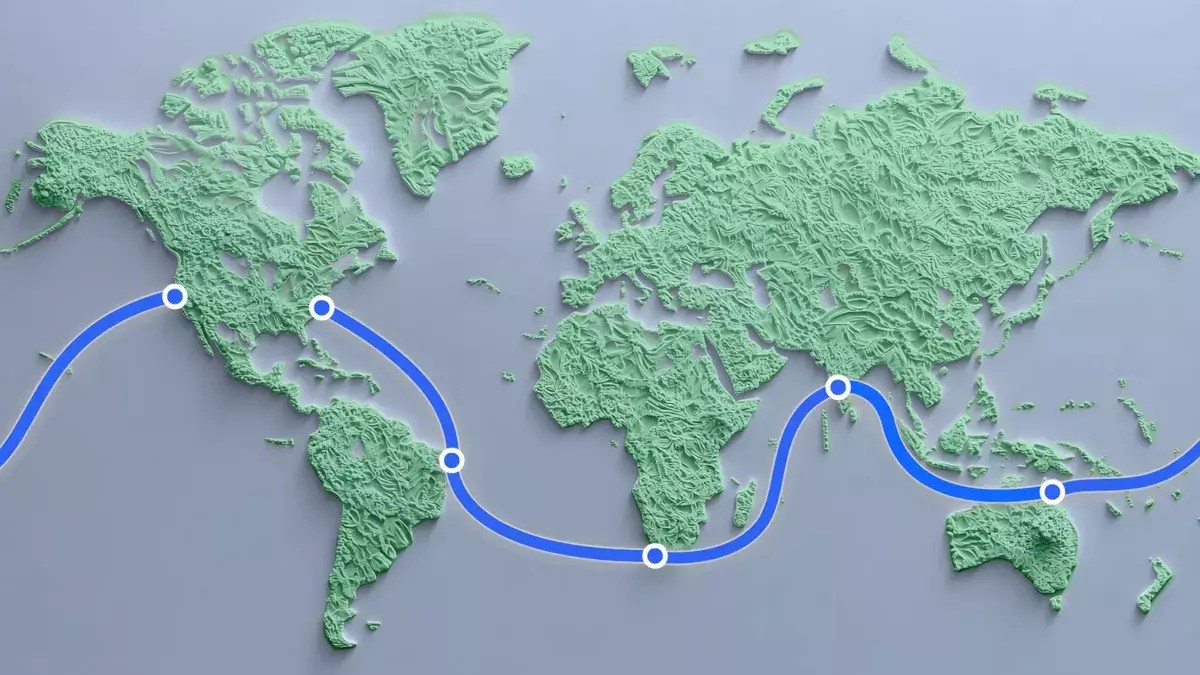In the digital landscape of 2025, where wireless technology seems to dominate our communications, the backbone of the Internet remains firmly anchored in the submerged depths of the ocean. An astounding revelation comes in the form of Meta’s upcoming initiative to install an undersea internet cable that is expected to surpass the Earth’s circumference—an endeavor referred to as Project Waterworth. This project underscores the tension between the visible, wireless advancements of our era and the hidden infrastructure that sustains our connectivity.
Meta’s ambitious plan entails a colossal undersea cable stretching approximately 31,000 miles (around 50,000 kilometers), with portions slinking as deep as four miles beneath the ocean surface. Connecting nations like the United States, India, South Africa, and Brazil, this cable aims to forge vital new corridors for high-speed internet traffic. Such an extensive network will not follow a simple geographical path. Instead, the cable will initiate on the US East Coast, weave its way down to Brazil, and traverse across the Atlantic before making a detour around the southern tip of Africa.
Once it has roamed the ocean depths, the cable will continue its journey toward Mumbai, India, and then on to Queensland, Australia, ultimately culminating with a return to California’s coastline. The undertaking is a multi-billion-dollar investment, reflecting Meta’s commitment not just to technological progress but also to global connectivity. By enhancing digital highways, the project sets the stage for future advancements in artificial intelligence and other innovations that require robust internet infrastructure.
Project Waterworth promises to be a game-changer not only in scale but also in its technical execution. Meta emphasizes an array of engineering advancements aimed at maintaining cable resilience. Among these innovations is the ambitious deployment of cables in depths reaching upwards of 7,000 meters (about 4 miles). This depth is crucial in mitigating risks linked to environmental hazards like ship anchors and seismic activity, which pose significant threats to underwater infrastructure.
The careful routing of the cable, particularly in high-risk fault zones, is noteworthy. Meta’s decision to adopt enhanced burial techniques further exhibits a proactive approach to safeguarding the cable against potential dangers. This commitment to cable resilience reaffirms the company’s intent to not only expand internet accessibility but to do so with a focus on reliability and longevity.
Despite this groundbreaking project, Meta faces a considerable public relations challenge. CEO Mark Zuckerberg’s recent decision to either eliminate or rework the roles of fact-checkers on social media platforms has drawn skepticism and criticism. Zuckerberg’s approach to prioritizing “community notes” over established fact-checking processes raises questions about the company’s accountability in curating information—a crucial aspect given the pervasive impact of misinformation across various platforms.
This inconsistency presents a duality in Meta’s image. On one hand, there’s the pioneering digital project that could redefine global connectivity; on the other, there’s the ongoing scrutiny of its influence as a social media giant battleground plagued with issues of trust and transparency. The juxtaposition of innovative infrastructure efforts against a backdrop of ethical questions complicates how the public perceives the company.
As our reliance on digital communication continues to escalate, the foundational elements that make this possible cannot be overlooked. Meta’s Project Waterworth stands as a monumental step toward enhancing global connectivity, creating an interwoven tapestry of communication that spans oceans and continents. While the project promises to bring high-speed internet access to underrepresented regions and accelerate technological innovations, it’s essential to maintain a critical eye on the company’s overall approach to information dissemination and community trust.
The world stands at the cusp of a new era of connectivity, but it is vital that as we reach for the stars of technological advancement, we are equally grounded in our ethical responsibilities. In the age of digital evolution, the tension between monumental infrastructural investments and the societal implications of digital communication underscores the complex narrative that shapes our interaction with technology.


Leave a Reply